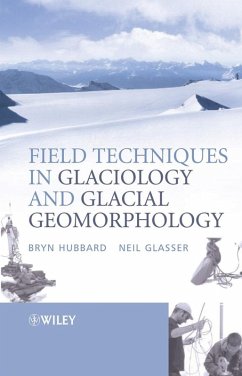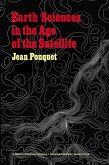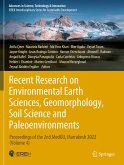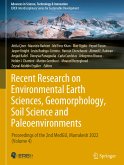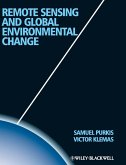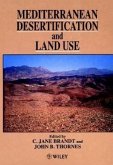- Broschiertes Buch
- Merkliste
- Auf die Merkliste
- Bewerten Bewerten
- Teilen
- Produkt teilen
- Produkterinnerung
- Produkterinnerung
"Field Techniques in Glaciology and Glacial Geomorphology" is the first text to provide this essential information in a single comprehensive volume. Coverage includes: The role of field data acquisition in the broader disciplines of glaciology and glacial geomorphologyLogistical preparations for fieldworkField techniques in glaciology such as investigations on ice and meltwatersField techniques in glacial geomorphology ranging from investigations on glacial landforms and sedimentsInternational case studies show each method in practice
Andere Kunden interessierten sich auch für
![Earth Sciences in the Age of the Satellite Earth Sciences in the Age of the Satellite]() J. PouquetEarth Sciences in the Age of the Satellite77,99 €
J. PouquetEarth Sciences in the Age of the Satellite77,99 €![The Glacial Boundary in Ohio, Indiana and Kentucky The Glacial Boundary in Ohio, Indiana and Kentucky]() George Frederick WrightThe Glacial Boundary in Ohio, Indiana and Kentucky28,99 €
George Frederick WrightThe Glacial Boundary in Ohio, Indiana and Kentucky28,99 €![Man and the Glacial Period Man and the Glacial Period]() G Frederick Wright (George Frederick)Man and the Glacial Period31,99 €
G Frederick Wright (George Frederick)Man and the Glacial Period31,99 €![Recent Research on Environmental Earth Sciences, Geomorphology, Soil Science and Paleoenvironments Recent Research on Environmental Earth Sciences, Geomorphology, Soil Science and Paleoenvironments]() Recent Research on Environmental Earth Sciences, Geomorphology, Soil Science and Paleoenvironments174,99 €
Recent Research on Environmental Earth Sciences, Geomorphology, Soil Science and Paleoenvironments174,99 €![Recent Research on Environmental Earth Sciences, Geomorphology, Soil Science and Paleoenvironments Recent Research on Environmental Earth Sciences, Geomorphology, Soil Science and Paleoenvironments]() Recent Research on Environmental Earth Sciences, Geomorphology, Soil Science and Paleoenvironments176,99 €
Recent Research on Environmental Earth Sciences, Geomorphology, Soil Science and Paleoenvironments176,99 €![Remote Sensing and Global Envi Remote Sensing and Global Envi]() Sam J PurkisRemote Sensing and Global Envi189,99 €
Sam J PurkisRemote Sensing and Global Envi189,99 €![Mediterranean Desertification and Land Use Mediterranean Desertification and Land Use]() Mediterranean Desertification and Land Use473,99 €
Mediterranean Desertification and Land Use473,99 €-
-
-
"Field Techniques in Glaciology and Glacial Geomorphology" is the first text to provide this essential information in a single comprehensive volume. Coverage includes: The role of field data acquisition in the broader disciplines of glaciology and glacial geomorphologyLogistical preparations for fieldworkField techniques in glaciology such as investigations on ice and meltwatersField techniques in glacial geomorphology ranging from investigations on glacial landforms and sedimentsInternational case studies show each method in practice
Produktdetails
- Produktdetails
- Verlag: Wiley
- Seitenzahl: 416
- Erscheinungstermin: 15. April 2005
- Englisch
- Abmessung: 228mm x 162mm x 23mm
- Gewicht: 599g
- ISBN-13: 9780470844274
- ISBN-10: 0470844272
- Artikelnr.: 21294447
- Herstellerkennzeichnung
- Libri GmbH
- Europaallee 1
- 36244 Bad Hersfeld
- gpsr@libri.de
- Verlag: Wiley
- Seitenzahl: 416
- Erscheinungstermin: 15. April 2005
- Englisch
- Abmessung: 228mm x 162mm x 23mm
- Gewicht: 599g
- ISBN-13: 9780470844274
- ISBN-10: 0470844272
- Artikelnr.: 21294447
- Herstellerkennzeichnung
- Libri GmbH
- Europaallee 1
- 36244 Bad Hersfeld
- gpsr@libri.de
Bryn Hubbard is the author of Field Techniques in Glaciology and Glacial Geomorphology, published by Wiley. Neil F. Glasser is the author of Field Techniques in Glaciology and Glacial Geomorphology, published by Wiley.
Preface ix
Acknowledgements xi
1 Introduction 1
1.1 Aim 1
1.2 The scope of this book 1
1.3 Book format and content 2
1.4 The role of fieldwork in glaciology and glacial geomorphology 3
1.5 The relationship between field glaciology and glaciological theory 4
2 Planning and conducting glaciological fieldwork 15
2.1 Aim 15
2.2 Designing and planning field-based research 15
2.3 Logistical preparations for fieldwork 20
2.4 Fieldwork data 26
3 Glacier ice: Character, sampling and analysis 30
3.1 Aim 30
3.2 Ice masses and ice facies: Principles, definition and identification 30
3.3 Sampling glacier ice 38
3.4 Ice analysis 55
3.5 Student projects 63
4 Glacier meltwater: Character, sampling and analysis 65
4.1 Aim 65
4.2 Background 65
4.3 Measuring bulk meltwater discharge: Stage-discharge rating curves 68
4.4 Sampling and analysing glacial meltwaters 79
4.5 Automated measurements by sensors and loggers 96
4.6 Tracer investigations 101
4.7 Student projects 112
5 Hot-water borehole drilling and borehole instrumentation 115
5.1 Aim 115
5.2 Introduction 115
5.3 Hot-water drilling 116
5.4 Borehole instrumentation 124
5.5 Summary 146
5.6 Student projects 146
6 Ice radar 148
6.1 Aim 148
6.2 Background and physical principles 148
6.3 Ice radar equipment 155
6.4 Radar data presentation 159
6.5 Field radar surveys 161
6.6 Processing 171
6.7 Field application and interpretation of ice radar 174
6.8 Student projects 177
7 Glacier mass balance and motion 179
7.1 Aim 179
7.2 Surface energy budget 180
7.3 Mass balance 187
7.4 Glacier motion and ice velocity 199
7.5 Student projects 216
8 Glacigenic sediments 217
8.1 Aim 217
8.2 Introduction to field sedimentology 217
8.3 Colour and organic content 226
8.4 Sediment texture 229
8.5 Particle morphology: The shape and roundness of sedimentary particles
232
8.6 Bedding 239
8.7 Sedimentary structures 243
8.8 Palaeocurrent data 245
8.9 Other properties 246
8.10 Field sampling techniques 247
8.11 Fabric analysis: General considerations 251
8.12 Clast macrofabrics 252
8.13 Clast microfabrics and microstructural description 259
8.14 Clast mesofabrics 260
8.15 Laboratory analysis 260
8.16 Interpreting the environment of deposition of sediments 262
8.17 Presentation of sedimentological data 266
8.18 Student projects 267
9 Mapping glaciers and glacial landforms 269
9.1 Aim 269
9.2 General considerations 269
9.3 Aims of the mapping and the areal extent of the map 270
9.4 Desk-based studies 271
9.5 Remotely sensed data 274
9.6 Geomorphological mapping 287
9.7 Field mapping 290
9.8 Field surveying techniques 304
9.9 Ground-penetrating radar and shallow seismic reflection investigations
of sediment bodies 308
9.10 Electrical resistivity surveys 311
9.11 Aquatic (marine and lacustrine) geophysical techniques 313
9.12 Mapping glacier structures (structural glaciology) 321
9.13 Final map compilation 325
9.14 Mapping and measurement of landforms change over time 327
9.15 Student projects 329
10 Monitoring and reconstructing glacier fluctuations 331
10.1 Aim 331
10.2 Remotely sensed images 332
10.3 Fieldwork mapping and historical documents 335
10.4 Dating glacier fluctuations using 'absolute age' (numerical-age) and
'relative age' estimates 339
10.5 Numerical-age dating techniques 340
10.6 Relative-age dating techniques 350
10.7 Dating glacier fluctuations - concluding remarks 364
10.8 Student projects 364
References 367
Index 396
Acknowledgements xi
1 Introduction 1
1.1 Aim 1
1.2 The scope of this book 1
1.3 Book format and content 2
1.4 The role of fieldwork in glaciology and glacial geomorphology 3
1.5 The relationship between field glaciology and glaciological theory 4
2 Planning and conducting glaciological fieldwork 15
2.1 Aim 15
2.2 Designing and planning field-based research 15
2.3 Logistical preparations for fieldwork 20
2.4 Fieldwork data 26
3 Glacier ice: Character, sampling and analysis 30
3.1 Aim 30
3.2 Ice masses and ice facies: Principles, definition and identification 30
3.3 Sampling glacier ice 38
3.4 Ice analysis 55
3.5 Student projects 63
4 Glacier meltwater: Character, sampling and analysis 65
4.1 Aim 65
4.2 Background 65
4.3 Measuring bulk meltwater discharge: Stage-discharge rating curves 68
4.4 Sampling and analysing glacial meltwaters 79
4.5 Automated measurements by sensors and loggers 96
4.6 Tracer investigations 101
4.7 Student projects 112
5 Hot-water borehole drilling and borehole instrumentation 115
5.1 Aim 115
5.2 Introduction 115
5.3 Hot-water drilling 116
5.4 Borehole instrumentation 124
5.5 Summary 146
5.6 Student projects 146
6 Ice radar 148
6.1 Aim 148
6.2 Background and physical principles 148
6.3 Ice radar equipment 155
6.4 Radar data presentation 159
6.5 Field radar surveys 161
6.6 Processing 171
6.7 Field application and interpretation of ice radar 174
6.8 Student projects 177
7 Glacier mass balance and motion 179
7.1 Aim 179
7.2 Surface energy budget 180
7.3 Mass balance 187
7.4 Glacier motion and ice velocity 199
7.5 Student projects 216
8 Glacigenic sediments 217
8.1 Aim 217
8.2 Introduction to field sedimentology 217
8.3 Colour and organic content 226
8.4 Sediment texture 229
8.5 Particle morphology: The shape and roundness of sedimentary particles
232
8.6 Bedding 239
8.7 Sedimentary structures 243
8.8 Palaeocurrent data 245
8.9 Other properties 246
8.10 Field sampling techniques 247
8.11 Fabric analysis: General considerations 251
8.12 Clast macrofabrics 252
8.13 Clast microfabrics and microstructural description 259
8.14 Clast mesofabrics 260
8.15 Laboratory analysis 260
8.16 Interpreting the environment of deposition of sediments 262
8.17 Presentation of sedimentological data 266
8.18 Student projects 267
9 Mapping glaciers and glacial landforms 269
9.1 Aim 269
9.2 General considerations 269
9.3 Aims of the mapping and the areal extent of the map 270
9.4 Desk-based studies 271
9.5 Remotely sensed data 274
9.6 Geomorphological mapping 287
9.7 Field mapping 290
9.8 Field surveying techniques 304
9.9 Ground-penetrating radar and shallow seismic reflection investigations
of sediment bodies 308
9.10 Electrical resistivity surveys 311
9.11 Aquatic (marine and lacustrine) geophysical techniques 313
9.12 Mapping glacier structures (structural glaciology) 321
9.13 Final map compilation 325
9.14 Mapping and measurement of landforms change over time 327
9.15 Student projects 329
10 Monitoring and reconstructing glacier fluctuations 331
10.1 Aim 331
10.2 Remotely sensed images 332
10.3 Fieldwork mapping and historical documents 335
10.4 Dating glacier fluctuations using 'absolute age' (numerical-age) and
'relative age' estimates 339
10.5 Numerical-age dating techniques 340
10.6 Relative-age dating techniques 350
10.7 Dating glacier fluctuations - concluding remarks 364
10.8 Student projects 364
References 367
Index 396
Preface ix
Acknowledgements xi
1 Introduction 1
1.1 Aim 1
1.2 The scope of this book 1
1.3 Book format and content 2
1.4 The role of fieldwork in glaciology and glacial geomorphology 3
1.5 The relationship between field glaciology and glaciological theory 4
2 Planning and conducting glaciological fieldwork 15
2.1 Aim 15
2.2 Designing and planning field-based research 15
2.3 Logistical preparations for fieldwork 20
2.4 Fieldwork data 26
3 Glacier ice: Character, sampling and analysis 30
3.1 Aim 30
3.2 Ice masses and ice facies: Principles, definition and identification 30
3.3 Sampling glacier ice 38
3.4 Ice analysis 55
3.5 Student projects 63
4 Glacier meltwater: Character, sampling and analysis 65
4.1 Aim 65
4.2 Background 65
4.3 Measuring bulk meltwater discharge: Stage-discharge rating curves 68
4.4 Sampling and analysing glacial meltwaters 79
4.5 Automated measurements by sensors and loggers 96
4.6 Tracer investigations 101
4.7 Student projects 112
5 Hot-water borehole drilling and borehole instrumentation 115
5.1 Aim 115
5.2 Introduction 115
5.3 Hot-water drilling 116
5.4 Borehole instrumentation 124
5.5 Summary 146
5.6 Student projects 146
6 Ice radar 148
6.1 Aim 148
6.2 Background and physical principles 148
6.3 Ice radar equipment 155
6.4 Radar data presentation 159
6.5 Field radar surveys 161
6.6 Processing 171
6.7 Field application and interpretation of ice radar 174
6.8 Student projects 177
7 Glacier mass balance and motion 179
7.1 Aim 179
7.2 Surface energy budget 180
7.3 Mass balance 187
7.4 Glacier motion and ice velocity 199
7.5 Student projects 216
8 Glacigenic sediments 217
8.1 Aim 217
8.2 Introduction to field sedimentology 217
8.3 Colour and organic content 226
8.4 Sediment texture 229
8.5 Particle morphology: The shape and roundness of sedimentary particles
232
8.6 Bedding 239
8.7 Sedimentary structures 243
8.8 Palaeocurrent data 245
8.9 Other properties 246
8.10 Field sampling techniques 247
8.11 Fabric analysis: General considerations 251
8.12 Clast macrofabrics 252
8.13 Clast microfabrics and microstructural description 259
8.14 Clast mesofabrics 260
8.15 Laboratory analysis 260
8.16 Interpreting the environment of deposition of sediments 262
8.17 Presentation of sedimentological data 266
8.18 Student projects 267
9 Mapping glaciers and glacial landforms 269
9.1 Aim 269
9.2 General considerations 269
9.3 Aims of the mapping and the areal extent of the map 270
9.4 Desk-based studies 271
9.5 Remotely sensed data 274
9.6 Geomorphological mapping 287
9.7 Field mapping 290
9.8 Field surveying techniques 304
9.9 Ground-penetrating radar and shallow seismic reflection investigations
of sediment bodies 308
9.10 Electrical resistivity surveys 311
9.11 Aquatic (marine and lacustrine) geophysical techniques 313
9.12 Mapping glacier structures (structural glaciology) 321
9.13 Final map compilation 325
9.14 Mapping and measurement of landforms change over time 327
9.15 Student projects 329
10 Monitoring and reconstructing glacier fluctuations 331
10.1 Aim 331
10.2 Remotely sensed images 332
10.3 Fieldwork mapping and historical documents 335
10.4 Dating glacier fluctuations using 'absolute age' (numerical-age) and
'relative age' estimates 339
10.5 Numerical-age dating techniques 340
10.6 Relative-age dating techniques 350
10.7 Dating glacier fluctuations - concluding remarks 364
10.8 Student projects 364
References 367
Index 396
Acknowledgements xi
1 Introduction 1
1.1 Aim 1
1.2 The scope of this book 1
1.3 Book format and content 2
1.4 The role of fieldwork in glaciology and glacial geomorphology 3
1.5 The relationship between field glaciology and glaciological theory 4
2 Planning and conducting glaciological fieldwork 15
2.1 Aim 15
2.2 Designing and planning field-based research 15
2.3 Logistical preparations for fieldwork 20
2.4 Fieldwork data 26
3 Glacier ice: Character, sampling and analysis 30
3.1 Aim 30
3.2 Ice masses and ice facies: Principles, definition and identification 30
3.3 Sampling glacier ice 38
3.4 Ice analysis 55
3.5 Student projects 63
4 Glacier meltwater: Character, sampling and analysis 65
4.1 Aim 65
4.2 Background 65
4.3 Measuring bulk meltwater discharge: Stage-discharge rating curves 68
4.4 Sampling and analysing glacial meltwaters 79
4.5 Automated measurements by sensors and loggers 96
4.6 Tracer investigations 101
4.7 Student projects 112
5 Hot-water borehole drilling and borehole instrumentation 115
5.1 Aim 115
5.2 Introduction 115
5.3 Hot-water drilling 116
5.4 Borehole instrumentation 124
5.5 Summary 146
5.6 Student projects 146
6 Ice radar 148
6.1 Aim 148
6.2 Background and physical principles 148
6.3 Ice radar equipment 155
6.4 Radar data presentation 159
6.5 Field radar surveys 161
6.6 Processing 171
6.7 Field application and interpretation of ice radar 174
6.8 Student projects 177
7 Glacier mass balance and motion 179
7.1 Aim 179
7.2 Surface energy budget 180
7.3 Mass balance 187
7.4 Glacier motion and ice velocity 199
7.5 Student projects 216
8 Glacigenic sediments 217
8.1 Aim 217
8.2 Introduction to field sedimentology 217
8.3 Colour and organic content 226
8.4 Sediment texture 229
8.5 Particle morphology: The shape and roundness of sedimentary particles
232
8.6 Bedding 239
8.7 Sedimentary structures 243
8.8 Palaeocurrent data 245
8.9 Other properties 246
8.10 Field sampling techniques 247
8.11 Fabric analysis: General considerations 251
8.12 Clast macrofabrics 252
8.13 Clast microfabrics and microstructural description 259
8.14 Clast mesofabrics 260
8.15 Laboratory analysis 260
8.16 Interpreting the environment of deposition of sediments 262
8.17 Presentation of sedimentological data 266
8.18 Student projects 267
9 Mapping glaciers and glacial landforms 269
9.1 Aim 269
9.2 General considerations 269
9.3 Aims of the mapping and the areal extent of the map 270
9.4 Desk-based studies 271
9.5 Remotely sensed data 274
9.6 Geomorphological mapping 287
9.7 Field mapping 290
9.8 Field surveying techniques 304
9.9 Ground-penetrating radar and shallow seismic reflection investigations
of sediment bodies 308
9.10 Electrical resistivity surveys 311
9.11 Aquatic (marine and lacustrine) geophysical techniques 313
9.12 Mapping glacier structures (structural glaciology) 321
9.13 Final map compilation 325
9.14 Mapping and measurement of landforms change over time 327
9.15 Student projects 329
10 Monitoring and reconstructing glacier fluctuations 331
10.1 Aim 331
10.2 Remotely sensed images 332
10.3 Fieldwork mapping and historical documents 335
10.4 Dating glacier fluctuations using 'absolute age' (numerical-age) and
'relative age' estimates 339
10.5 Numerical-age dating techniques 340
10.6 Relative-age dating techniques 350
10.7 Dating glacier fluctuations - concluding remarks 364
10.8 Student projects 364
References 367
Index 396

